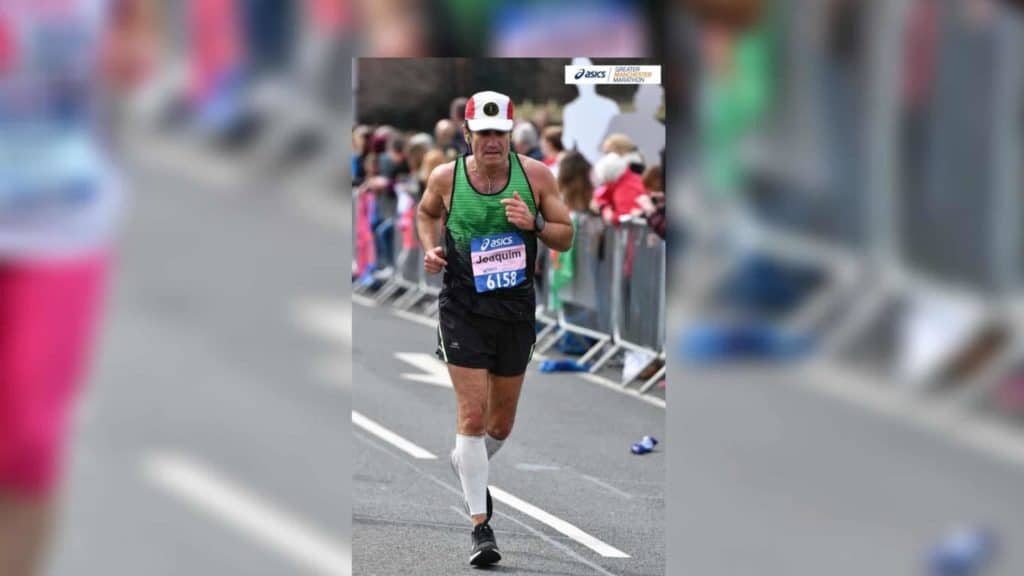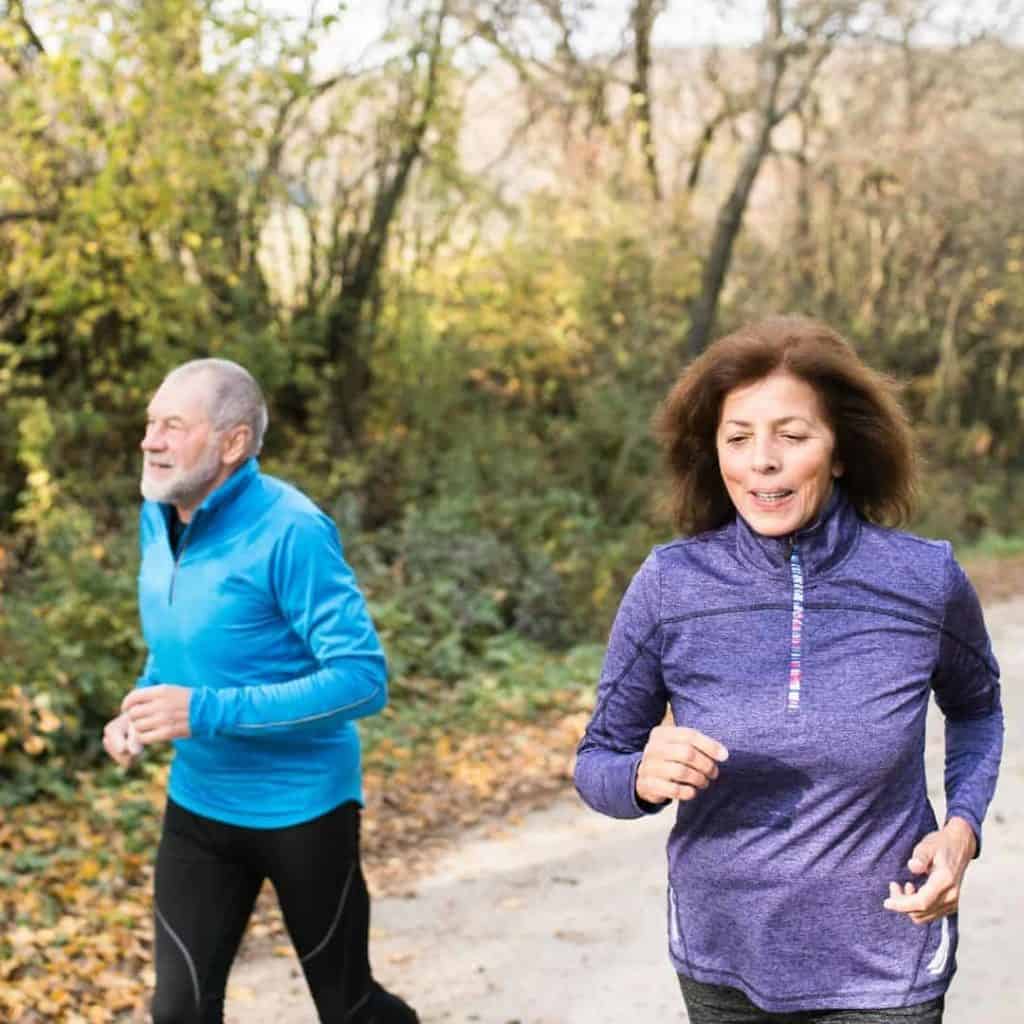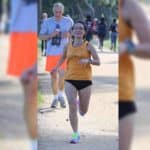Tony Vicente has been a part of Team CoachParry for a few years now and has gone from strength to strength even though he says his age is “now a factor”
Tony writes his story here:
The year I turned 50 and effectively retired, it was also the year I relocated to the Middle East, I was running somewhat inconsistently. My running consisted of 3-6 days of training, but because I was a portfolio Group CEO I was travelling locally, regionally and internationally many times apart from a 60hr work week.
Training runs were always measured in miles rather than time with the time and average pace for each run closely monitored by all at the club – it was a rugby club that ran in the off-season – no easy running per se but rather just running (below tempo) and never jogging! That was a word that was never used….
Once or twice a week there was a track session or a tempo session. Sunday’s were always long runs but rather than focusing on the time spent running, the key was always “how far”. In most cases, the long runs would be hard and recovery was always an issue.
I used to sit in a bath and then add cold water slowly – the water was always so cold – it was effectively an ice bath!
By 2010 the internet was becoming an area full of various programs that were often discussed over a beer or two but regardless of the minor changes the principle remained that one needed to run mileage and mileage to get faster and fitter i.e Volume!
“No pain no gain”.
The ideal, we were always told, was 6 days of running per week with the key runs: track 400 or 800 mostly, tempo and long runs. The other three would never be below 6miles long and were done on an effort below marathon pace – we were told this was around 15-20sec below.
There was never any of this “ be able to hold a conversation pace” stuff.
That was the training in a nutshell.

My Comrades Marathon Journey
When I arrived in the Middle East and agreed to an initial contract I decided to start running again rather than merely jogging to keep fit. In 2015 I decided to run the Comrades Marathon in 2016.
This was a big bucket list item for me having grown up in Durban. I basically followed the same routine I had done with the short track sessions done on the treadmill. I ran the Dubai marathon pretty easily in 4:17 and then I did Manchester Marathon in 4:04.
That was the race that got me worried as I really trained well (so I thought) and after a good first half, to my surprise, the wheels just fell off. My legs gave in at 32k even though I had done a large volume of training.
Anyhow the mission was a Sub-11 hour Comrades Marathon. I ran the whole way with the bus and arrived at 10:54. The following year (2017) I ran the Dubai Marathon again and Comrades Marathon again (another sub 11 hour).
And I managed to do this again in 2018. All my times were within 2 minutes of each other, while following Lindsey’s free bronze program on the Comrades website, and while it was hard I always felt at the end that I still had plenty in the tank.

I knew there was more to give albeit my age was now a factor. But even though I was running more and more, my Comrades qualifying marathons were not getting easier.
In 2019 I decided to give it a go and run sub 10 Comrades and a sub a 4 hr marathon again without the training killing me in the process.
I needed to make a change
In all my reading and internet search, a common theme that was emerging was that a coach was the quickest way to get the most out of one’s training. Letting someone else figure out what was best based on the stats/data rather than trying to follow a generic program that could be either too much or too little…
That’s when I decided that I needed to get a 1on1 coach and I joined Coach Parry and started to get coached by Markus.
I loved the fact that all I needed to do was run after looking at the program. My busy work schedule involves managing a 15 000 person workforce multi-billion group and this is stressful enough without having to then think about training.
But I must say, when I first joined that I was initially concerned at the relatively lower mileage prescribed – but I kept with it. The biggest change I felt initially, above all, was the rate of recovery.
Previously after a week of running, I always struggled for at least 2 days, often cutting my runs because I just felt tired. But now I was surprised that even with back to back runs I was always ready to crack on without having to take pain tablets for aching muscles.
Granted the previous training for Comrades had got the body used to the slog but somehow I felt fresher.
The changes started coming
In 2019 I ran the Bahrain marathon as a training run keeping to the prescribed power level. I ran it as a long run with no taper in 4:27 but with no recovery issues at all.
Later I ran the Manchester marathon with almost no taper in 3:56 – only because I ran with a sub4 pacer group – no doubt in my mind it was physically the easiest marathon I had run in years, chatting all the way around like in a training run.
A month later I ran another marathon as a training run and felt the fittest I had felt in the last 10 years – I was 56!
Comrades 2019 I did 10:22 having been forced to walk all the way from Polly due to an ITB issue. I felt gutted as I knew sub 10 was more than within my capability – but I was also quietly pleased because I knew I could do it.
So what was the overriding difference between the two periods?
I think the first was getting a coach and a personalised training plan. Secondly, and in my opinion/experience the most important change, was running easy for non-specific runs which in my program were all runs except for one speed/hill work or progressive long runs.
I do think the hard sessions really do make the difference in improving fitness –but no doubt the ability to run hard only came to me because I was taking my easy runs easy.
No huffing and puffing at the end of the run and only that good feeling that one always gets after doing physical exercise. These runs, who everyone previously had called junk miles, in my opinion, make all the difference.
And CoachParry’s philosophy of running slower to run faster is the real secret- I believe. (If you’d like to discover more about Coach Parry’s unique approach to training as a 50+ year old runner, then register for our upcoming Faster Beyond 50 Masterclass)
At my age apart from having the satisfaction of running which I have always loved, I can also do it because I recover well. I honestly think this is due to the easy miles and the strength training.
Regards, Tony
Let’s tackle the 5k
When the pandemic and lockdown hit in 2020, along with the limitations of training in the heat in Bahrain, Markus and Tony decided to keep things fun and exciting and see what Tony was capable of over the 5km distance.
At the start of this training block in July, Tony’s 5km PB was 22:53 and after 4 blocks of 4 weeks he had smashed it down to 20:53. His progression of times went as follows:
Block 1 15/06/2020 – 12/07/2020 : 22:53 → 22:35
Block 2 13/07/2020 – 30/07/2020 : 22:35 → 21:46
Block 3 31/07/2020 – 27/09/2020 : 21:46 → 21:20
Block 4 28/09/2020 – 13/11/2020 : 21:20 → 20:53
[We’ll be publishing an article soon on the details of the process and plan Tony & Markus used to achieve such amazing goals, so keep an eye out for that]

When asking Coach Markus what contributed to Tony’s phenomenal results this is what he had to say :
“There were a few things that played a big part in Tony’s performance. Here are a few of the things we focused on…”
- Training at the correct paces was absolutely key.
- Recovery was also a big focus. It always is, but this was particularly true in the third block
- Consistency with strength training
- Pacing was vital. The three different tools we used for pacing each played a really important role. Power, heart rate and pacing.
- Using power rather than pace for easy runs
- We always kept an eye on his heart rate to see if he was recovering enough.
- For speed-work, we used only pacing based on previous time trials. This was to be very specific. For hill work, we also used power based on his critical power.
- The last and very subconscious training tool we had was Tony’s treadmill. Because of temperatures between 43-52°, running outside wasn’t an option. Besides having the above-mentioned tools, having the treadmill enabled us to really dial in the exact pace and hold it there.
- Whenever it was time for the next TT, we were VERY specific about pacing and running strategy. We would be sure to start at the same or a few seconds/km slower than the average of the previous TT. Around 1-1,5km in, try to build up to the same as the previous TT pace or a few seconds faster. Hold that up to 3km. If possible, pick up the pace for the 4th km. If not, hold steady and nurse home. And then in the last kilometre… always empty the tank.
Coach Markus on the importance of pacing…”Be in control of the process”
– It is key to start your time trials more conservative and most importantly, stay in control of the process… You will have your best possible run for that day!
– If you start too hard, fatigue sets in and run out of speed because your intensity level was too high to start with, the process will start to control you!
– So either focus on info from your watch / GPS unit but also try to develop that “feel”. To have an idea of if a specific pace or level of effort is sustainable for the duration of your race is absolutely key.
Why is it good to run slow?
– It trains your respiratory, cardio and muscular systems to be more efficient.
– Effectively adapting your body’s ligaments, tendons, bones and joints to the stress of running with less metabolic cost to your physiology
– Teaches patience, discipline and how to handle physical discomfort.
– In Tony’s case, it allowed him to recover well. I say it like this as he really knows how to run easy… I’ve never seen him push harder than he should in his easy sessions and he listens to his body really well.
Tony is an excellent example of using easy runs to manage his load & recovery and therefore being fresh enough to run his quality/interval runs at the required speed. It has been amazing to watch Tony run some of his best times in his 50’s, a time where so many others are slowing down! Well done Tony! Looking forward to the next steps of your journey.
If you’d like to discover more about running well (and faster) in your 50’s and beyond, then be sure to save your seat in our free upcoming Faster Beyond 50 Masterclass below:

Join us for a free online presentation of the…
The Faster Beyond 50 Masterclass
…and discover how you can run well (and faster) as you get older, without training more or harder than you currently are, all while avoiding injury.
If it feels like you’re training harder than ever but not running the paces you’d like to be running or if you’re constantly tired, fatigued or running in some sort of pain, then this is specifically for you.



Comments are closed.